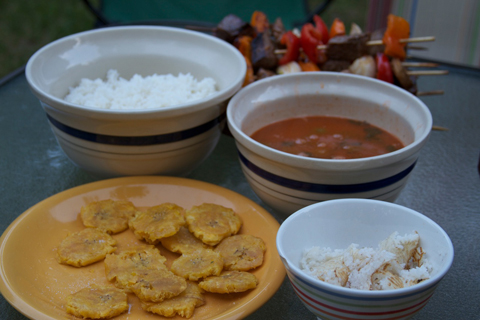
A POST-COLUMBIAN FEAST Clockwise from top left: white rice, meat kabobs (American!), Dominican beans, rice crust from the bottom of the pan, and tostones. |
In August, Angel Ferreras, 39, did what any Dominican would do. I was looking for his neighbor who wasn't home, and he invited me over for dinner. He didn't know me. It wasn't a special occasion. But as he explains, "In Dominican, everybody is like family." You wave over anyone you see in the neighborhood and hang out together.
"What are we having?" I asked. His teenage daughter, Pamela, responded, in English and in Spanish: "Vamos a comer la bandera." The dish name translates to "the flag" and consists of rice, beans, and meat with twice-fried plantains, called tostones, on the side. Dominicans eat la bandera so often that it apparently defines the country as much as the flag.
In his kitchen Angel covers a cup of red pre-cooked beans with water in a small pot. He adds a tablespoon of diced green pepper, a tablespoon of sliced red onion, a teaspoon of salt, two shakes of Goya Adobo seasoning, and a teaspoon of oregano powder. When the water starts to boil he adds four ounces of tomato sauce and two tablespoons of fresh chopped cilantro; he lets it cook for half an hour. The green plantains look like giant green bananas. He peels the skins off the hard, cream-colored flesh with a paring knife, slices the flesh into medallions, and shallow-fries them on medium heat until they turn sunflower yellow.
Then his American girlfriend, Robin Hetzler, got out a tostonera, a wooden contraption for smashing the fried plantain rounds into flatter circles. After she smashed the medallions, she passed them to Angel, who fried them again. He served the beans in their cooking liquid on top of the white rice along with the tostones and meat, which tonight was his girlfriend's shish kabobs marinated in sofrito, garlic, vinegar, and oil, then grilled. My whole family agreed when I made this meal for them at home that la bandera was delicious — a keeper, and especially beloved because it's so easy to make. My kids said the tostones were almost as good as French fries. (I think they're better!)
I couldn't have selected a more perfect dish to make as Columbus Day approaches, because Columbus's first permanent settlement was actually on Hispaniola, the very same island where la bandera is cooked 500 years later. The natives weren't cooking it when Columbus arrived because they had never experienced rice, cilantro, oregano, plantains, or garlic. The Spanish weren't cooking it before he arrived because they had never experienced the wonders of green peppers, tomatoes, or these bean varieties. It was only after his voyages that knowledge of these tasty edible plants and sources of energy was shared.
I always feel uncomfortable on Columbus Day because the celebration completely ignores the tragic reality of what happened, leaving unacknowledged the sorrow and loss of hundreds of thousands of native people as both a direct and indirect result of his voyages. On that island alone, in just 15 years after Columbus arrived, the estimated initial population of 250,000 Arawak natives fell to just 14,000. And this is not mention that we're celebrating a man who was bull-headed and wrong about pretty much everything. (This wasn't a New World. People had been living there for thousands of years thank you very much. And this isn't India!) What we all can celebrate together is that in 1492 for the first time in human history, for better or for worse, we started becoming one world. Let's celebrate the best of our togetherness: Change Columbus Day to One World Day and make la bandera.